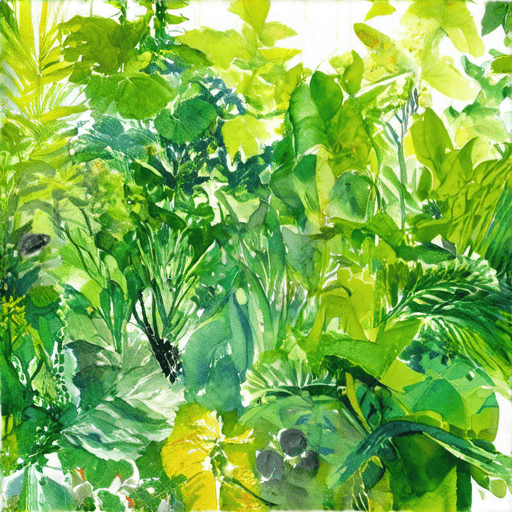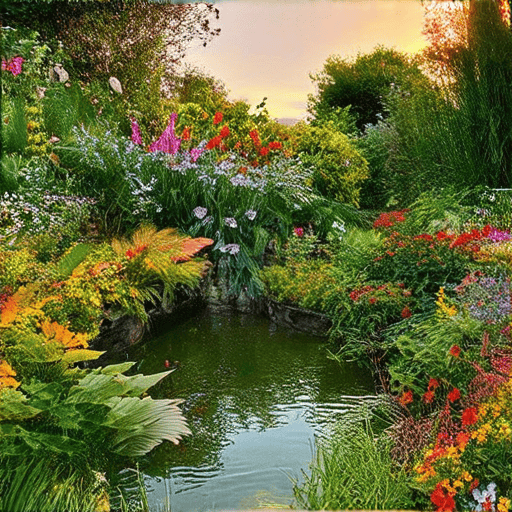As we continue to navigate the complexities of modern life, many of us are turning to green gardening as a way to reconnect with nature and promote sustainable living. But what exactly does it mean to practice green gardening? At its core, green gardening is about cultivating a thriving eco-friendly oasis that not only nourishes our bodies but also supports the health of our planet. By embracing organic methods, conserving water, and reducing waste, green gardeners can create vibrant spaces that bring joy and serenity to their lives.

What is the Meaning of Green Gardening?
Green gardening refers to a holistic approach to cultivating plants and gardens while minimizing harm to the environment and promoting sustainability.
- Organic Practices: Green gardening emphasizes the use of organic fertilizers, compost, and pest control methods that are free from synthetic chemicals and toxins.
- Sustainable Water Management: This approach encourages efficient water usage through techniques like rainwater harvesting, drip irrigation, and mulching.
- Biodiversity and Ecosystem Services: Green gardening aims to create diverse ecosystems that support local wildlife, pollinators, and beneficial insects.
- Reduced Waste and Carbon Footprint: By adopting green gardening practices, individuals can reduce their carbon footprint, minimize waste, and promote recycling.
Key Principles of Green Gardening
- Soil Conservation and Improvement: Green gardening focuses on building healthy soil through the use of compost, cover crops, and minimal tillage.
- Pest and Disease Management: This approach relies on integrated pest management (IPM) techniques, crop rotation, and biological controls to maintain ecosystem balance.
- Efficient Resource Use: Green gardening promotes the use of renewable energy sources, reduces water consumption, and optimizes fertilizer application.
- Community Engagement and Education: By sharing knowledge and experiences, green gardeners can foster a sense of community and promote sustainable gardening practices.
Benefits of Green Gardening
- Improved Air and Water Quality: Green gardening helps to remove pollutants, reduce greenhouse gas emissions, and conserve water resources.
- Increased Biodiversity and Ecosystem Services: By creating diverse ecosystems, green gardening supports local wildlife, pollinators, and beneficial insects.
- Enhanced Food Security and Nutrition: Green gardening promotes access to fresh, nutritious food, and supports local food systems.
- Economic Benefits and Job Creation: Sustainable gardening practices can generate income, create jobs, and stimulate local economies.
Getting Started with Green Gardening
To begin your green gardening journey, start by assessing your current gardening practices and identifying areas for improvement.
- Assess Your Soil: Test your soil type, pH level, and nutrient content to determine the best amendments and fertilizers.
- Select Climate-Suitable Plants: Choose plants adapted to your region’s climate, soil conditions, and available sunlight.
- Implement Integrated Pest Management: Develop a IPM plan that incorporates physical barriers, cultural controls, and biological controls.
- Monitor and Evaluate Progress: Regularly track your progress, adjust your strategies as needed, and share your experiences with others.
What is a Green Garden?
A green garden is a type of garden that prioritizes sustainability and minimizes its impact on the environment.
-
We define a green garden as a space that incorporates eco-friendly practices, such as:
-
Using organic and locally sourced materials
-
Implementing rainwater harvesting systems
-
Reducing water consumption through efficient irrigation methods
-
Minimizing chemical usage through integrated pest management
-
Creating habitats for local wildlife
-
Our approach to gardening emphasizes the importance of biodiversity, soil health, and efficient resource use.
-
By adopting these principles, we can create gardens that not only thrive but also contribute positively to the environment.
Key Principles of a Green Garden
-
Biodiversity: Incorporating a variety of plants, trees, and flowers to support local ecosystems
-
Soil Health: Maintaining healthy soil through composting, mulching, and minimizing tillage
-
Water Efficiency: Implementing drought-tolerant plants, rainwater harvesting, and efficient irrigation systems
-
Pest Management: Using integrated pest management techniques to minimize chemical usage
-
Waste Reduction: Reducing waste through composting, recycling, and repurposing materials
Benefits of a Green Garden
A green garden offers numerous benefits, including:
-
Improved air and water quality
-
Increased biodiversity and ecosystem services
-
Reduced greenhouse gas emissions and climate change mitigation
-
Enhanced aesthetic appeal and recreational value
-
Increased property values and community engagement
Getting Started with a Green Garden
To create a green garden, start by assessing your current gardening practices and identifying areas for improvement.
-
Conduct a soil test to determine nutrient levels and pH
-
Assess your water usage and implement efficient irrigation methods
-
Introduce native plants and incorporate pollinator-friendly species
-
Implement integrated pest management techniques and reduce chemical usage
-
Compost and recycle materials to reduce waste
By following these steps and incorporating eco-friendly practices, you can create a thriving green garden that benefits both you and the environment.

Is Growing a Greener World Still on PBS?
As a long-time advocate for sustainable living, I’m excited to share the latest updates on Growing a Greener World.
- The show remains available to stream on PBS and the free PBS App, accessible on various devices including iPhone, Apple TV, Android TV, Android smartphones, Amazon Fire TV, Amazon Fire Tablet, Roku, Samsung Smart TV, and Vizio.
- Eco-friendly enthusiasts can continue to enjoy the show’s inspiring episodes, which cover topics like organic gardening, renewable energy, and eco-conscious lifestyle choices.
- For those interested in exploring more sustainable living resources, I recommend checking out Eco Planeta Verde, a platform dedicated to sharing practical tips and inspiring stories on eco-friendly practices.
- Additionally, fans of Growing a Greener World may also want to explore other popular shows like Gardeners’ World and Plant for the Planet.
As we strive to live more sustainably, it’s essential to stay informed and inspired by the many amazing initiatives and individuals working towards a greener world.
Where to Watch Growing a Greener World:
- PBS
- PBS App
- iPhone
- Apple TV
- Android TV
- Android smartphones
- Amazon Fire TV
- Amazon Fire Tablet
- Roku
- Samsung Smart TV
- Vizio
Stay Connected with Eco-Friendly Resources:

How to Make Your Garden Green
To create a lush and vibrant garden, start by selecting plants that thrive in your local climate and soil type.
- Choose the Right Plants: Select plants that are native to your region or have similar growing conditions. Consider factors like sunlight, water requirements, and soil pH.
- Prepare the Soil: Test your soil to determine its pH level and nutrient content. Add organic matter like compost or manure to improve soil fertility and drainage.
- Water Wisely: Water your plants deeply but infrequently to encourage deep root growth. Avoid overwatering, which can lead to shallow roots and increased susceptibility to disease.
- Maintain Proper Fertilization: Use balanced fertilizers that provide essential nutrients for plant growth. Avoid overfertilizing, which can harm plants and the environment.
- Prune Regularly: Prune plants to promote healthy growth, increase air circulation, and remove diseased or damaged branches.
- Control Pests and Diseases: Monitor your plants regularly for signs of pests or diseases. Use integrated pest management techniques to minimize chemical use and protect beneficial insects.
- Add Mulch and Compost: Mulch around plants to retain moisture, suppress weeds, and regulate soil temperature. Add compost to improve soil structure and fertility.
- Consider Companion Planting: Some plants benefit from being grown alongside others, such as marigolds repelling nematodes or basil improving tomato flavor.
- Monitor and Adjust: Continuously monitor your garden’s progress and adjust your care routine as needed. Keep records of weather patterns, soil conditions, and plant performance to inform future decisions.
By following these steps and staying committed to regular maintenance, you’ll be well on your way to creating a thriving and beautiful garden.
Tips for Specific Climate Zones:
- Tropical Climates: Choose heat-tolerant plants, provide shade, and maintain high humidity levels.
- Desert Climates: Select drought-resistant plants, conserve water, and protect plants from extreme temperatures.
- Cold Climates: Choose hardy plants, provide protection from frost, and maintain adequate snow cover.
Additional Resources:
What Nutrient Makes Plants Greener?
Sulfur plays a crucial role in plant growth, particularly in the production of chlorophyll, which gives plants their characteristic green color.
- Chlorophyll Production: Sulfur is essential for the synthesis of chlorophyll, the green pigment responsible for photosynthesis. Without sufficient sulfur, plants may appear yellowish due to a lack of chlorophyll.
- Healthy Roots: Sulfur helps promote healthy root development, allowing plants to absorb nutrients and water efficiently.
- Soil pH Regulation: Sulfur has a mild acidifying effect on the soil, helping to regulate its pH levels and create a favorable environment for plant growth.
While sulfur deficiencies are relatively rare, they can occur when the soil lacks adequate amounts of this essential nutrient. To ensure optimal plant health, gardeners and farmers often supplement their soil with sulfur-based fertilizers or organic matter rich in sulfur compounds.
Eco-friendly gardening practices emphasize the importance of maintaining balanced soil conditions, including adequate sulfur levels, to support healthy plant growth and minimize the need for synthetic fertilizers.
For more information on sustainable gardening techniques and eco-friendly practices, visit our Sustainable Gardening Tips page.
Additionally, learn how to create a balanced fertilizer blend using natural ingredients on our Natural Fertilizer Blend guide.
Discover the benefits of composting and how it can enrich your soil with essential nutrients on our Composting Benefits page.
By incorporating these eco-friendly gardening practices into your routine, you’ll be well on your way to growing healthier, more resilient plants that thrive in a balanced and sustainable environment.

Can You Put Epsom Salts on Plants?
Epsom salt has been gaining popularity among gardeners due to its numerous benefits for plant growth.
- Improves Soil Structure: Epsom salt contains magnesium sulfate, which helps to loosen clay soils and improve drainage, allowing roots to grow deeper and stronger.
- Boosts Nutrient Uptake: Magnesium in Epsom salt plays a crucial role in photosynthesis, helping plants absorb essential nutrients like nitrogen, phosphorus, and potassium.
- Increases Bloom and Fruit Production: Epsom salt can enhance flower and fruit production by promoting healthy cell growth and development.
How to Use Epsom Salt on Plants:
- Dissolve 1-2 tablespoons of Epsom salt in 1 gallon of water.
- Substitute this solution for regular watering once a month.
- For potted plants, you can also mix 1 tablespoon of Epsom salt into the soil before planting.
Benefits for Specific Plant Types:
- Trees and Shrubs: Epsom salt can help promote root growth and improve nutrient uptake, leading to healthier trees and shrubs.
- Fruits and Vegetables: Epsom salt can enhance bloom and fruit production, resulting in better yields and flavor.
- Houseplants: Epsom salt can help improve soil structure and boost nutrient uptake, promoting healthy growth and development.
Precautions and Considerations:
While Epsom salt can be beneficial for plants, it’s essential to use it in moderation and according to the recommended dosage.
- Avoid Overuse: Excessive Epsom salt application can lead to magnesium toxicity, causing damage to plants.
- Choose the Right Type: Make sure to use pure Epsom salt (magnesium sulfate) and not table salt or other types of salt.
Conclusion:
Epsom salt can be a valuable addition to your gardening routine, providing numerous benefits for plant growth and development.
By following the recommended usage guidelines and taking necessary precautions, you can harness the power of Epsom salt to create a thriving and healthy garden ecosystem.

0 Comments